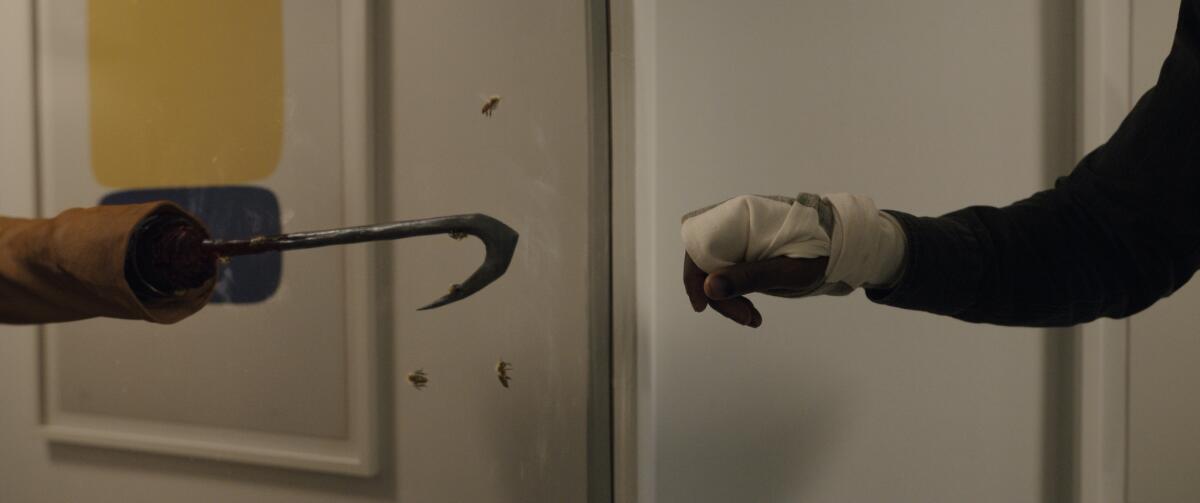Review: Nia DaCosta stakes her claim with the terrifying and artful ‘Candyman’

The Times is committed to reviewing theatrical film releases during the COVID-19 pandemic. Because moviegoing carries risks during this time, we remind readers to follow health and safety guidelines as outlined by the Centers for Disease Control and Prevention and local health officials.
Skyscrapers loom out of the fog, drifting by upside down as if from the point of view of someone on a gurney, or perhaps as spectral presences occupying land that’s been stolen, developed, appropriated, allocated, gentrified and re-developed again. This is the Chicago of Nia DaCosta’s “Candyman,” a reboot/sequel to the 1992 horror film directed by Bernard Rose. DaCosta’s film builds upon the horrors imagined by the original, which introduced the terrifying imagery of a man with a hook, surrounded by bees, a monster forged in racist violence, a mysterious figure and an urban legend that gives meaning to the horrors of a ghetto manufactured by white supremacy.
DaCosta, who made her directorial debut with the remarkable abortion drama “Little Woods,” firmly announces herself as an artist at work with “Candyman,” a genuinely terrifying and artful horror film that speaks with a bell-clear voice to the current moment, the product of centuries of racist power structures. While the original centered a white woman in a story of the horrors of the African American experience (and indeed, the white woman is often an incendiary and complicit figure in such tales), DaCosta’s film, which she wrote with producers Jordan Peele and Win Rosenfeld, centers a Black man, an artist named Anthony McCoy (Yahya Abdul-Mateen II). Here, a black man occupies the space of both the villain and the victim, sliding between persecuted and monstrous identities — horror tropes as social commentary.
This “Candyman” functions best as a sequel, with the story of the original film acting as the inciting myth, the urban legend of the grad student who went to the ‘hood to learn about Candyman (rendered spookily with puppet silhouettes, an ongoing motif). It’s relayed as all scary stories are, an oral tradition passed on by candlelight, as told by Troy (Nathan Stewart-Jarrett) to his sister Brianna (Teyonah Parris) and her boyfriend Anthony during a dinner party. The story takes hold of Anthony, a painter struggling to find new inspiration, and he heads to the old housing projects of Cabrini-Green searching for anything he can find about the myth of Candyman. In this version, art takes the place of academia as a space for processing the mythology of the ghetto.
He finds it in William Burke (Colman Domingo), who tells him the tales he grew up with of an old man with a hook for a hand doling out candy, about the police violence he witnessed, the warning that if you say his name five times in the mirror, Candyman will appear. Armed with these tales, Anthony is inspired to create a mirrored piece titled “Say My Name,” though the white bourgeois art world isn’t so receptive. That world is soon rocked by a series of grisly, bloody murders as Anthony’s life begins to spin out of control, his reality a constant waking nightmare.
DaCosta crafts an eerie cinematic world that is anchored by a deeply harrowing and sorrowful performance by Abdul-Mateen, who begins to occupy a space like that of Frankenstein’s monster, of this world and a monster within it, as he delves deeper and deeper into the Candyman legend. A cool and creepy score by Robert Aiki Aubrey Lowe underlines the disquieting cinematography by John Guleserian, off-kilter angles that show Chicago from a strange and scary point of view, and seemingly normal interactions made menacing. Within this world, DaCosta weaves a tale of a mythical monster that is a product of racist violence, including police brutality. There’s power in a name, as seen in the protests of the Black Lives Matter movement. As “Candyman” reminds us, say his name and incur the consequences, or, invoke his protection.
Katie Walsh is a Tribune News Service film critic.
‘Candyman’
Rated: R, for bloody horror violence, and language including some sexual references
Running time: 1 hour, 31 minutes
Playing: Starts Aug. 27 in general release
More to Read
Only good movies
Get the Indie Focus newsletter, Mark Olsen's weekly guide to the world of cinema.
You may occasionally receive promotional content from the Los Angeles Times.










